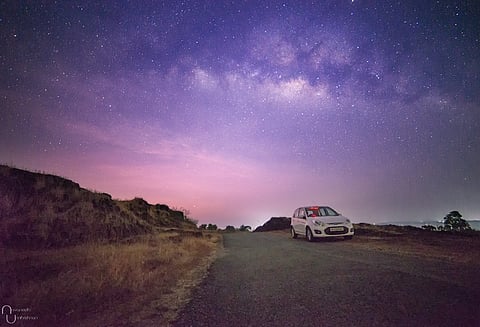

Navaneeth Unnikrishnan, a 22-year-old journalism student in the Manipal School of Communication makes sure that he takes time off at least once a month to travel to various places in India, to practice his skills at photography.
But if you’re imagining 500 Likes on a Facebook page for photographs of birds and bees, wait till you hear of what his subjects are: the skies.
Navaneeth specializes in astrophotography - capturing the Milky Way Galaxy's dust rings and large stars, nebulas and comets in the night sky.
(The Indian Astronomical Observatory in Hanle, Ladakh)
He travels because, even though everyone technically is under the same non-existent sky, the results from different locations and therefore altitude gives you different kinds of spectacular images.
“You attach your camera to a high focal length telescope which must track your object in extreme precision and must also be in synchronization with the rotation of the earth. No vibrations are allowed and you're focusing on extremely dim objects which can’t be seen until the image is shot. You also have to nail down the correct exposure with all this," Navaneeth, a native of Calicut tells The News Minute.
(A shot from the Kasargod district in Kerala)
The possibility for such photography occurred to him around two years ago. "I got a chance to see the Milkyway galaxy from my backyard after I got a telescope. I did not know we could shoot deep space objects then," Navaneeth says.
After he read some articles on the internet regarding the possibilities of astrophotography, there was no going back.
"It was a gradual process. You can't figure out deep space imaging in a day or a week. It takes time, practice and lots of research regarding the location you go, to check for factors like light pollution, weather, wild animals among other things. Your first attempt is going to be bad," he adds.
(A view near Ujire in Karnataka)
Navaneeth agrees that there's a lot of potential in the field for India as we get some of the best views in the Himalayas. "The only issue is reaching these remote locations with the gear," he says.
What does the gear involve? A telescope, a tripod, two cameras, one telephoto lens, two wide angle lenses and some spare batteries. "You will also have to camp overnight, if you want to do it properly," he adds.
(The skies, around 80 kms from Bengaluru)
For now, Navaneeth plans to finish his course and is presently working on a time lapse video which will be out by next year. "Travel wise, I plan to visit Kashmir or Ladakh next year.
For more detailed explanations on how astrophotography is done, visit Navaneeth's Facebook page here. Watch a trailer of the time lapse video here.